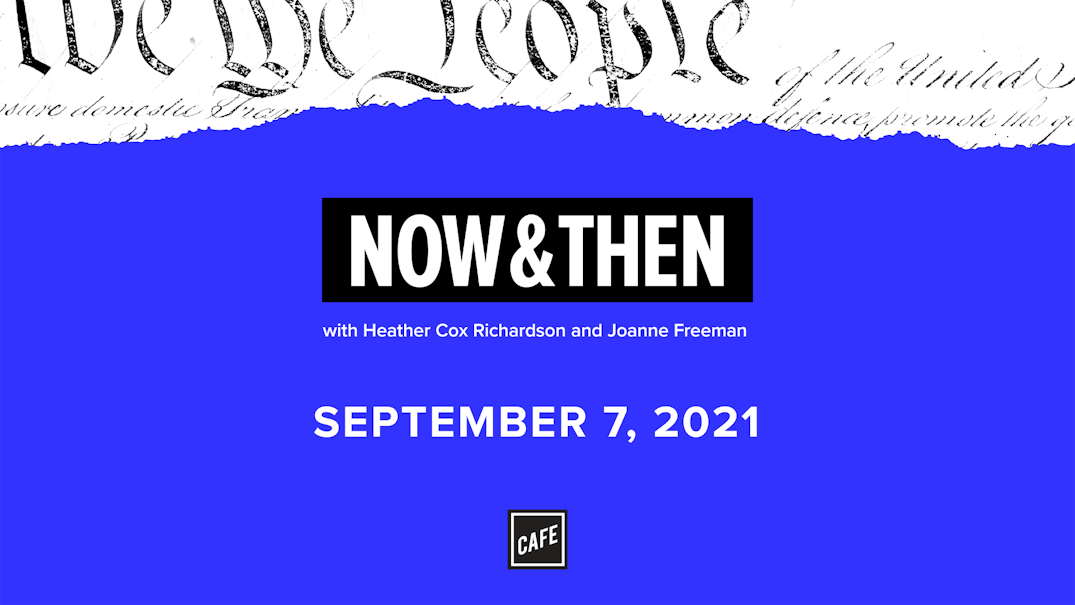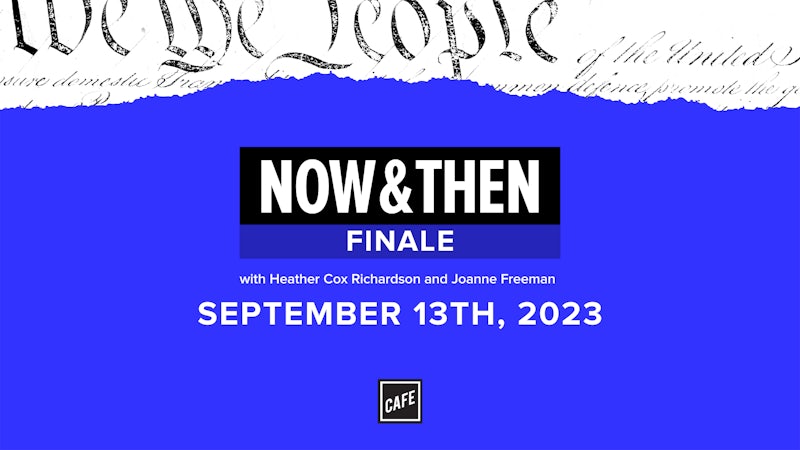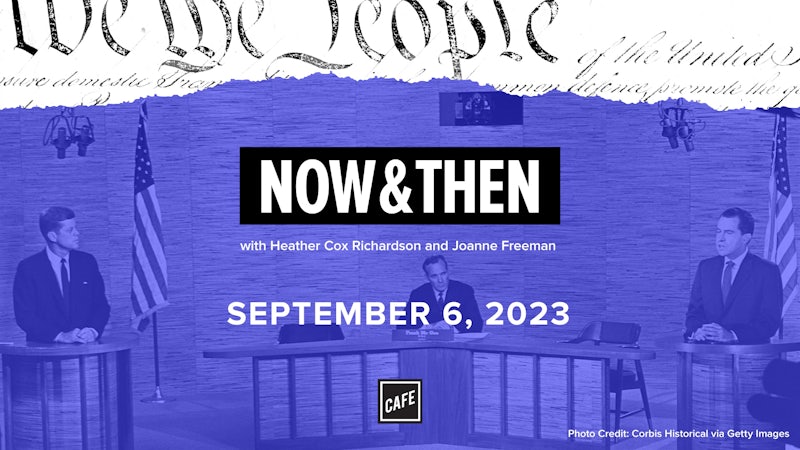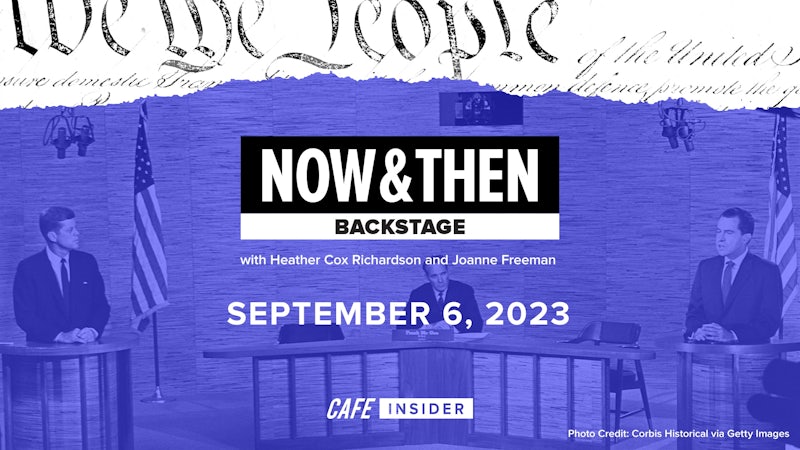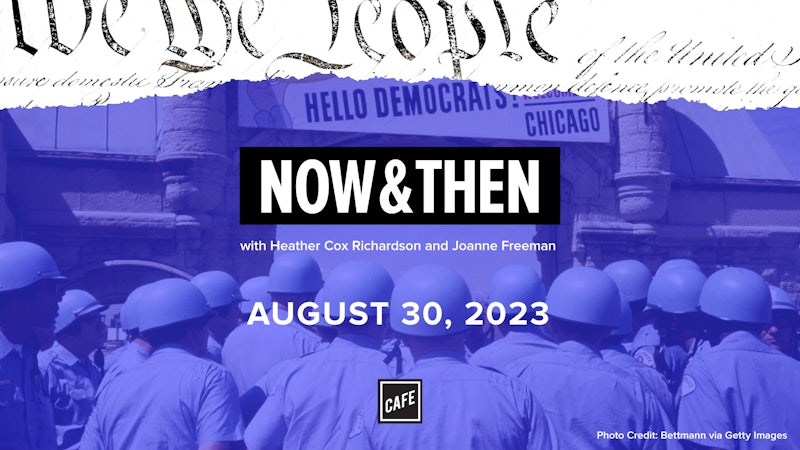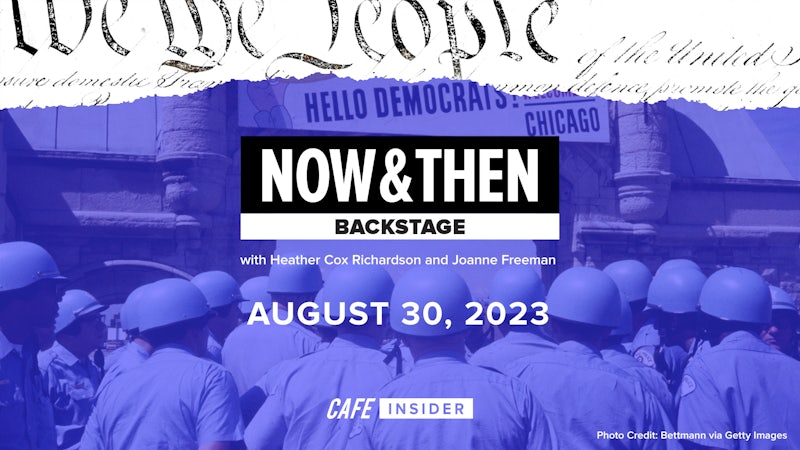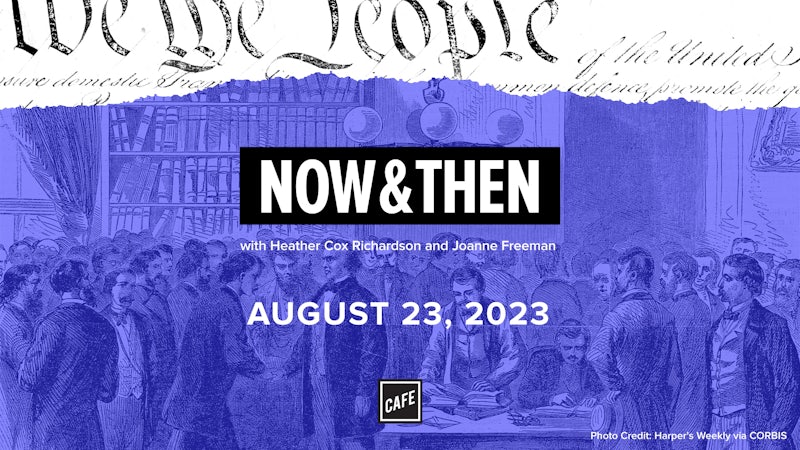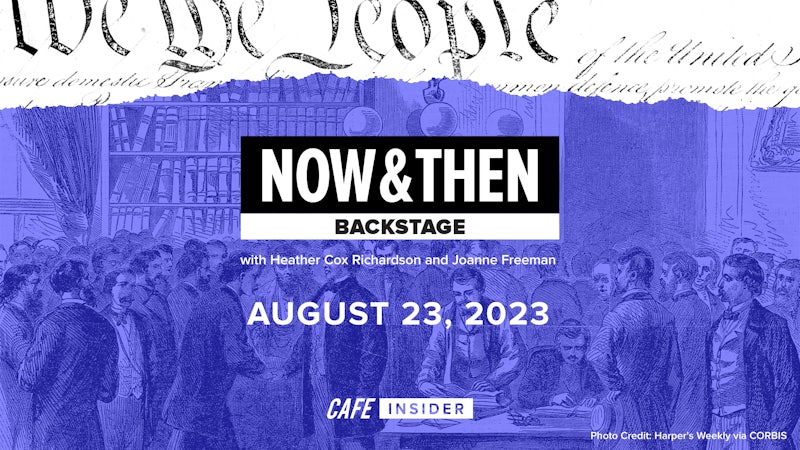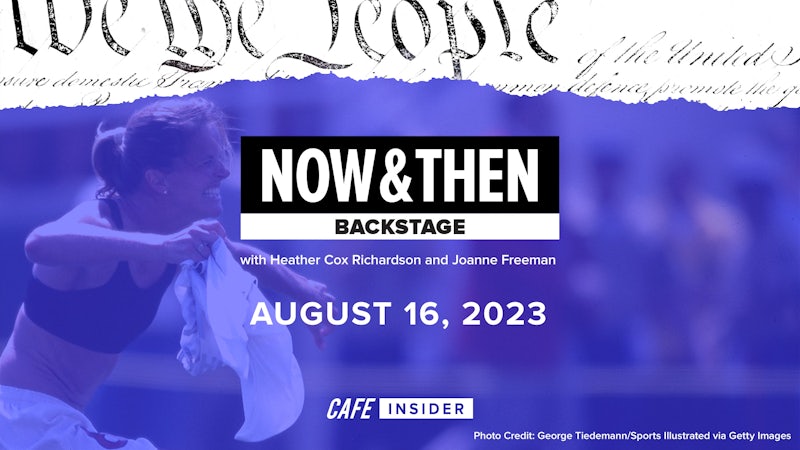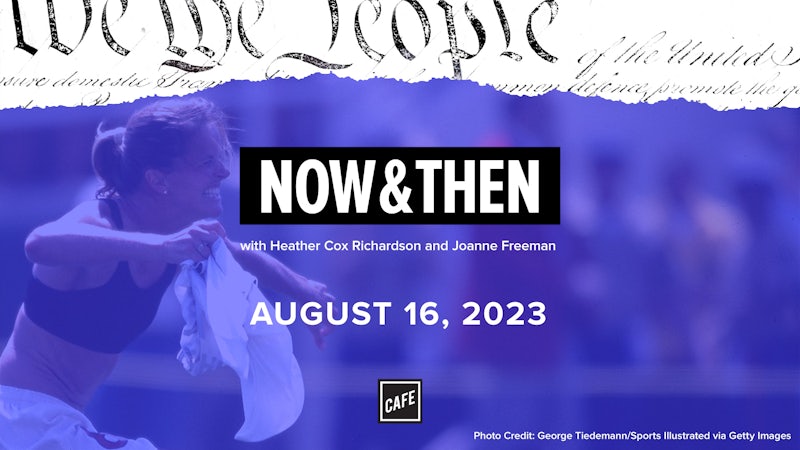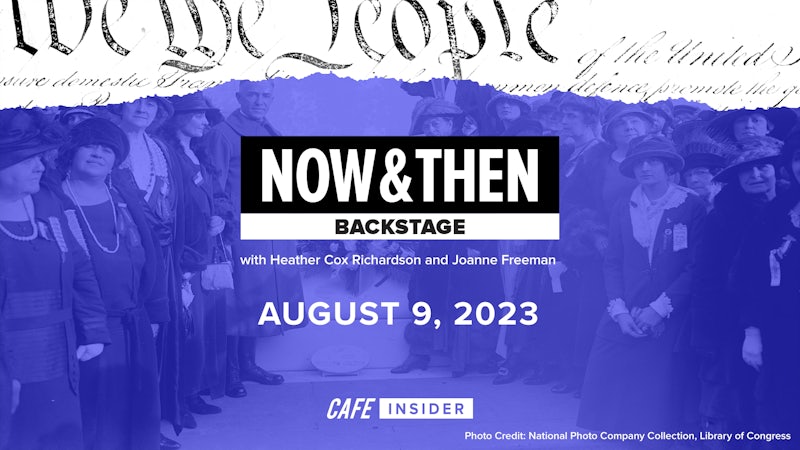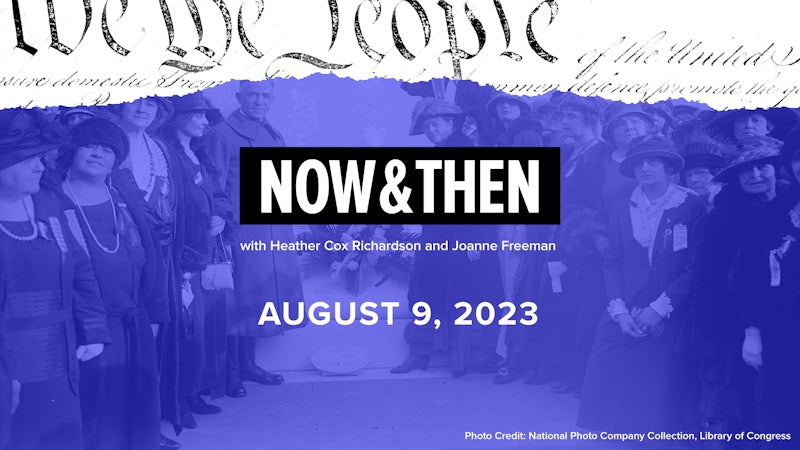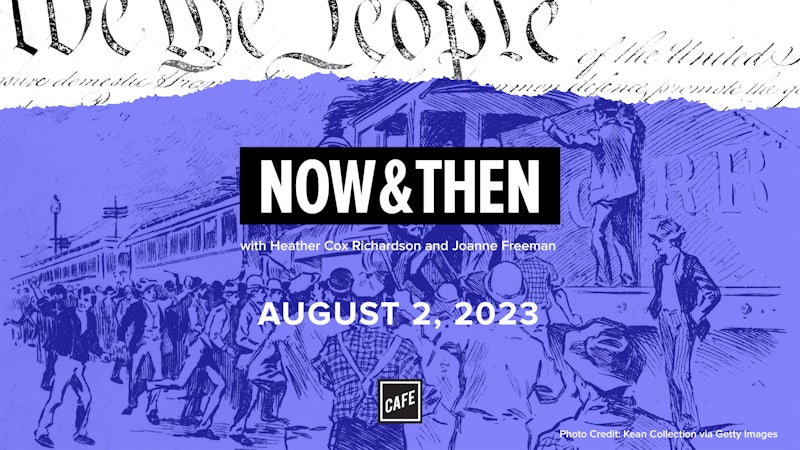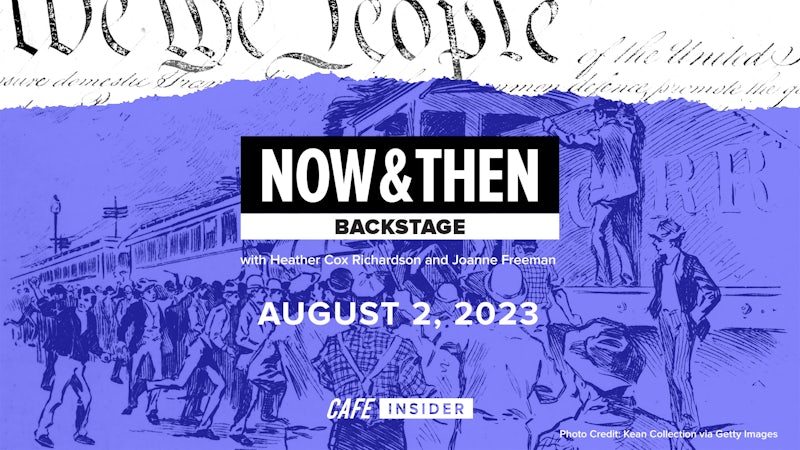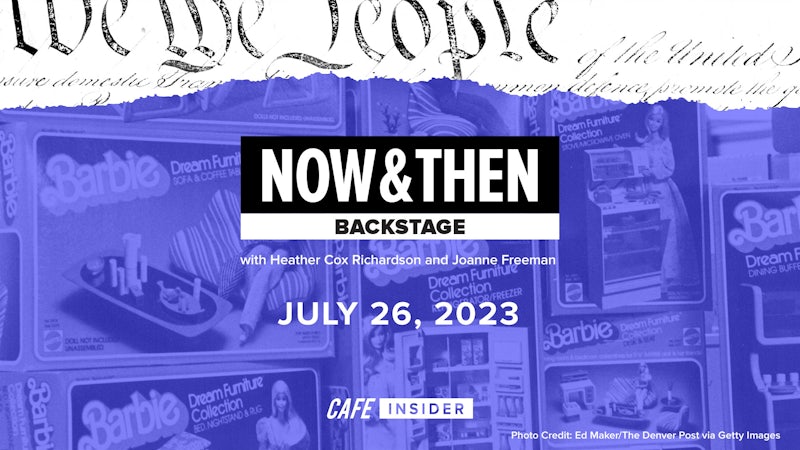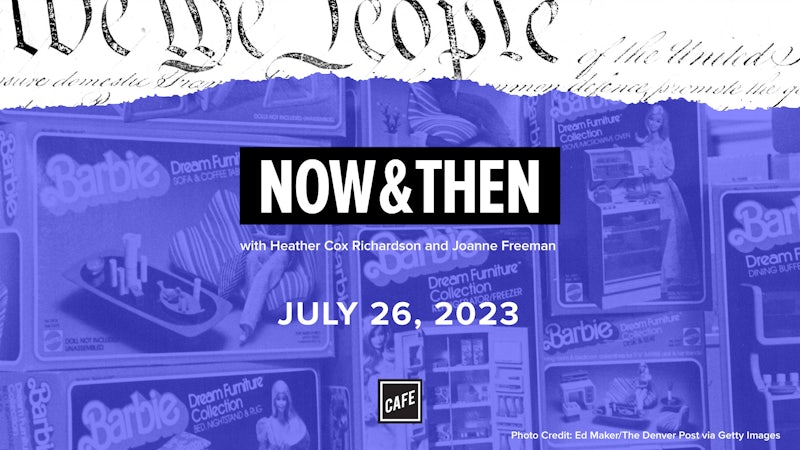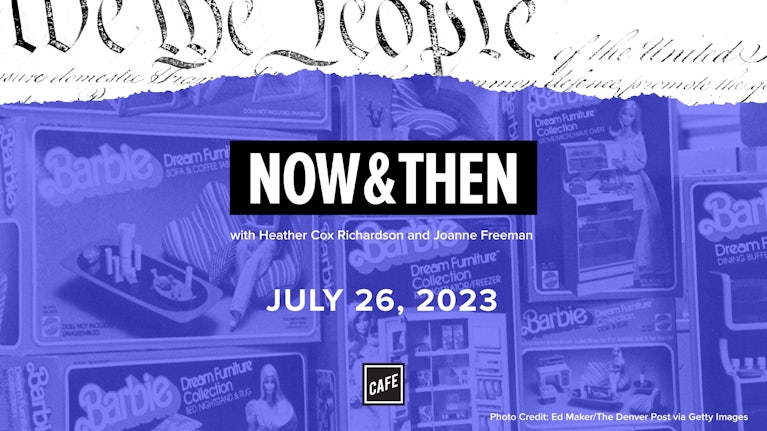Heather Cox Richardson:
From CAFE and the Vox Media Podcast Network, this is Now & Then. I’m Heather Cox Richardson.
Joanne Freeman:
And I’m Joanne Freeman. Today we want to discuss a topic that, in some ways, is probably on everyone’s mind right about now, and that is climate and climate change. Now, I want to start out by saying something which maybe is obvious to many, but I think is often discussed by many and might be a little unclear, and that is the difference between climate and weather. They’re not the same thing.
So, weather… this is according to the US Geological Survey, so I have my footnote here… weather refers to short term atmospheric conditions. Climate is the weather of a specific region averaged over a long period of time. So, when we’re talking about climate, we’re talking about long term change. Weather is not the same thing as climate. And so what we want to talk about today is climate. There are obvious reasons for doing so. Obviously, the wildfire problem in the West is huge. There have been millions of acres that have been burning in the United States this year, I think actually, that as of September 1st, more than 4.5 million acres have burned in the United States and California has been hit the hardest. And right now actually, the Caldor fire is blazing out of control. I think it’s destroyed over 190,000 acres, and it’s just 16% contained.
So, we have the fire problem and the fact that that’s a reoccurring problem, and then of course, we have hurricanes generally, and tornadoes, actually. And hurricane Ida, which made landfall in Louisiana as a category four hurricane with winds up to 150 miles per hour, and then made its way to the east coast, where it smacked up against a variety of different states along the east coast. I was in New York City for part of it and was bemused and a little scared by the fact that all I saw all over social media were people saying, “Wait, wait, flood warnings and a tornado warning in New York City. Like, really? But this doesn’t happen here.”
So, what we want to talk about is climate; how over time we’ve thought about climate, how over time people have changed their views about what it is, who controls it, and how or if it can be controlled, and maybe more than anything else, how do we frame our understanding of climate and why is that important?
Heather Cox Richardson:
As you were talking about climate as environment, I’m sitting over here thinking, “We’re going to be talking about climate as environment, but also as politics and social life,” because I think you can make a really good argument that America has formed its self-identity in part around the idea that Americans can do whatever they want. And that’s a theme that we’d like to take through the course of this podcast, talking about how that’s changed over time and how the way we react to the climate and interface with the climate says a lot about who we are at any one time. And we have to start with the obvious place, Joanne, which is a minute and a half ago… No, I’m kidding… which is the colonists in America and how they approached the landscape and what they thought that the landscape meant when they found it the way they did.
Joanne Freeman:
And in a sense, this will not be surprising to many, but given that the colonists and then the early United States was a nation defined, in one way or another by land, climate and weather were both things that were very much on people’s minds all the time. The assumption or one of the things that supposedly set the United States and the colonies apart from Europe and the rest of the world was the seeming availability of land, which of course, is erasing all of the indigenous people who lived on that land, but still, that was seen as one of the distinct supposed advantages of settling in North America and spreading colonization West in North America.
Heather Cox Richardson:
And when the colonists arrive after the virgin soil population epidemics that really decimate the indigenous population, what they find is a land that looks to them like an Eden. I mean, they are coming from… especially if we’re talking here about the English colonists… coming from a land where there was a real shortage of food and there weren’t any trees because they’d all been cut down, and you come to the North American coastline and you find rivers teeming with fish, I mean, just teeming with fish, and trees everywhere, and even in places in Plymouth Colony, for example, when the settlers first start exploring the land around the cape, around what is now Cape Cod, finding caches of food in the ground, of course, that had been buried by the indigenous people but who were now dead.
So, the colonists start to look at this, what they consider, a new land… of course, it’s an ancient land with people who’ve always lived here, but they look at that and that helps them to define what this land and their relationship to it is going to be.
Joanne Freeman:
Absolutely. Although the counter side of that, so on the one hand, for sure, there’s forms of wildlife that hadn’t been seen before, there are amounts, vast amounts of everything because they hadn’t been farmed in the same way that they had been forever in Europe, but the weather, just the atmosphere, the fact that particularly in New England, it was cold, and to them, to many people, barren, and harsh, and seemingly primitive, there were ways in which the weather felt off-putting to people.
And so I think what we’re going to see a lot throughout this episode, what you end up having is people thinking about the climate and thinking about the weather, trying to understand and make sense of it, and then coming up with a narrative that suits the mind frame of the people at the time.
So, in the case of early New England, and actually just the North America generally, there was a popular belief that the climate could be changed by settlement… surprise… by colonization and settlement, and that the more that you farmed land, and drained marshes, and cleared forests, and cultivated soil, the better the climate would be. And actually, in researching this today, what I discovered is that for some reason, Harvard had cornered the market on people who were actually totally persuaded that this was a true fact. There’s a Harvard professor named Samuel Williams who wrote Change of Climate in North America and Europe in 1789, and he said, “Every climate is becoming more temperate and uniform.” He was thinking about the rise of what he would have seen as civilization. And he said, “This will continue to be the case so long as diligence, industry, and agriculture shall mark the conduct of mankind.”
So, productivity, defined by a sort of settler/colonists point of view, in their mind was a way that humankind could control the climate and make it better. Also, noteworthy, though, in this period, is the fact that climate was linked up with questions of race. And the idea very early on… another Harvard professor, as I said, they cornered the market, Hugh Williamson, 1771, he immediately links climate with the color of people’s skin, and he’s not the only one to do so.
But in speaking about North America, he wrote, “While America remained a great forest inhabited by savages,” which tells you what they considered this place was before settlers arrived… “under the constant dominion of westerly winds, there was not any climate on the eastern coast in which we could expect a fair skin. By the progress of cultivation, the general course of the winds is materially affected, and in the process of time, we may expect such a prevalence of easterly winds near the coast in those states and shall prevent the tendency of complexion to the clear brunette to dark skin, which prevails in temperate climates in other parts of the world.”
So, basically, in a variety of different ways, these early settlers and North American thinkers are assuming they can change the climate for the better, that their presence and the ways in which they’re manipulating the land will make that change, and in the course of doing that will make the land more friendly towards people of their complexion… to quote Williamson… and less friendly to people of other skin complexions.
Heather Cox Richardson:
And what jumps out to me when you read those quotations is the degree to which those men think that those changes are going to serve their economy but also implies a sort of power, that not only do we have power over our families, for sure, and certainly people of color, we even have dominion over the earth, that is, we get to do what we want with the earth, and not only do we have the right to do that, we’re going to improve it as we go.
And that’s certainly something that feeds directly into the 19th Century and into the idea of westward expansion, for example, with the idea that so long as there was land out there that Americans could move into, they could continue to preserve democracy, they could continue to preserve a certain kind of economy, and they can certainly spread a certain kind of religion, and that idea of taking in new lands, either through things like the Homestead Act of 1862, which gives people land on which to farm, and even like you say, of using plows to turn up the dirt. The idea was that in the mid 19th century was that you would take the Great Plains which were known at the time as The Great American Desert, and use plows to turn the dirt up as opposed to the grass, and that dark soil would draw rain down onto it. So, the dry plains are going to become arable land and they’re going to be farms all over them simply by virtue of the fact that Americans have moved on to it.
Well, it’s so interesting, especially in the 19th Century, because even by then, it’s becoming clear that the ways in which the Euro-American settlers used the land and affect the climate is quite different than the indigenous Americans who have centuries and centuries and generations of ways of interacting, interfacing, as a community or communities, with that land, that is far healthier and far more sustainable, but the Euro-American settlers can’t see that. That is not their vision of the economy, of spirituality, or their vision of who should be in control.
This whole idea really brings to mind the Reclamation Act in 1902, which was what Teddy Roosevelt… I’m sorry, Theodore Roosevelt said… You kind of get personal with these people… said was the most important thing he ever signed, which is really astonishing when you think about it, because the Reclamation Act or the Newlands Act, as it was known, because it’s backed by a guy named Newlands, literally was the Americans under the form of the US government going into the West and damming all the waters to turn all the land in the West into farmland. But I love the title of that, because it’s not the change the environment law, and it’s not the, we’re going to-
Joanne Freeman:
Or betterment of whatever act.
Heather Cox Richardson:
No, it’s the reclamation. They’re going to reclaim the land, they’re going to reclaim that world to what it is in their, I guess, ideal fantasy.
Joanne Freeman:
But in the case of Roosevelt, he is someone who is interesting as a figure because he had these sort of broad causes, the environment and masculinity that he propounded in a way that’s interesting, but also, all of them, in one way or another, are about power.
Heather Cox Richardson:
They’re about power, and that raises a really interesting question by the time you get to the Reclamations Act, for example, because it’s pretty clear that the rise of industry in the late 19th Century is using natural resources in such a way that it’s enormously destructive. I mean, they’re pouring crap into the rivers, they’re cutting down all the trees, they’re polluting the air, and they’re increasingly using public natural resources in ways that are really destructive.
And that brings up a really interesting attitude, and we have to pick here on our friend and buddy, Teddy, again, because he gets concerned about the loss of the natural world for America, because he believes that if in fact we turn the entire country over to big business, we will end up killing what it is that makes us American, makes us fundamentally American. And that’s actually how we get our first national park in 1872 with Yellowstone, Yellowstone National Park. And that’s just as settlers are pouring into the West, and there’s real questions when you look at something like the Grand Canyon, should you in fact put up toll booths and say, “You can only come in if you pay me”? And that’s something that by the late 19th Century, a lot of Americans are thinking, “No, that in fact, our natural resources should not be monopolized by big business.”
And that comes really obviously clear over Yosemite, because in 1864, Abraham Lincoln had actually gone ahead and signed a bill that gave Yosemite Valley and the Mariposa Big Tree Grove to the state of California, with the idea that, as he said, “The premises shall be held for public use, report, and recreation, and that they shall be in alienable for all time.” But what happens is that the state of California begins to lease the lands that become what we now know of as the Yosemite National Park, they begin to lease those to sheep farmers, and the sheep really just destroy the place. And by the turn of the century, conservationists, people like John Muir go and take a look at Yosemite, which is just a spectacular site, if anybody has seen it now, and they look at the fact that it’s essentially a sheep farm, it’s essentially like a polluted sheep farm. And they’re like, “Well, this is not going to stand.”
And so they start a move to get the federal government to go ahead and take power away from the states to protect that land, because they know… and this is something that’s very clear in the late 19th Century that people have tended to forget… it’s really, really easy to corrupt a state legislature because it’s just not that big, and the prices are not that high to buy a legislator, whereas it’s much harder to corrupt the federal government because you might be able to buy off, in this case, somebody from California, but somebody from New Hampshire might be like, “Forget it. I’m not going to get anything from the sheep farmers.” So they go ahead and they try to federalize the idea of national parks.
And then in 1903, John Muir… John Muir is a really interesting fellow. I wish I could tell you John Muir stories. But John Muir was 65 years old then, and he goes ahead and he takes Theodore Roosevelt on a camping trip, and they actually slip away from the Secret Service agents, can you imagine? I guess, very early version of hiking the Appalachian Trail. And they disappear… I’m sorry, they’re going to have to cut that. And they disappear for three days camping, and a lot of historians think that it was during that excursion that John Muir really emphasized to Theodore Roosevelt the necessity for the federal government to go ahead and protect the environment to continue to enable Americans to have access to the sublimity in our natural resources.
So, in fact, he did as president. He becomes president in 1901 after McKinley is assassinated, he’s president from 1901 to 1909, and he actually establishes five new national parks, and then he goes ahead and signs something called the Antiquities Act, which lets him preserve significant landmarks, historic structures and pre historic structures and things that are of scientific interest. And so that’s actually through the Antiquities Act that we get the preservation of things like portions of the Grand Canyon. Again, at the time, big discussion about turning the Grand Canyon commercial. And he says, “No, we have to preserve these spaces for the country as a whole, because we have a social interest in preserving this land.”
Joanne Freeman:
And that’s a point that’s worth noting and that I think we’ll be noting again, which is the message underlying a lot of what’s going on here is us, it is for us. We are protecting the land for Americans, we are protecting the land for the nation, that this is something that is about, I guess you could say, Americanness, and it’s a democratic message, maybe even a populist kind of a message that it’s ours and that we should be protecting it.
Again, the ways in which climate and land and nature are, in one way or another, politicized and woven into larger views about what the nation is, it’s hardly a surprise that those go hand in hand.
So, a great example of what Heather just mentioned about this view about the land and Americanness and democracy is something that Roosevelt said when laying the cornerstone of the gateway to Yellowstone National Park in 1903. He said, “I cannot too often repeat that the essential feature in the present management of the Yellowstone Park, as in all similar places, is its essential democracy. It is the preservation of the scenery, of the forests, of the wilderness life and the wilderness game for the people as a whole instead of leaving the enjoyment thereof to be confined to the very rich who can control private reserves.” So, it’s this democratic kind of populist message about what the federal government is doing is for the people, is for us.
Heather Cox Richardson:
But in that moment, it’s not just about preserving places like Yosemite, and Yellowstone, and the Grand Canyon, and the other places, the turn of the last century, we make international parks or protect under the Antiquities Act, that’s actually the period when Americans have to begin to grapple with the fact that the extraordinary overbuilding of the landscape and the lack of protection of our more vulnerable places is causing a huge problem. And the hurricane that hits Galveston, Texas in 1900 is one of those events in American history that a lot of people don’t know about. A category four hurricane descends on Galveston, Texas on September 8th, 1900. And, again, we don’t have modern day weather predictions at the time. They knew a storm was coming but they had no concept it was going to be as bad as it was, and it is truly devastating.
So, for a project once, I read the newspapers around the Galveston hurricane, so they’re getting reports back from Galveston and there are trains, for example, going into the storm, and reports coming back until in that case, the train is lost. And they have people writing notes from the top of buildings. And at the end of the day, more than 3,600 buildings were destroyed, the winds were more than 135 miles an hour, and the death toll was between 6,000 12,000 in a city of only 40,000. And the reaction of the city government was really pathetic, in a sense. It was at the time a pretty corrupt city government and they couldn’t manage to handle digging out after the storm. And one of the things that really jumped out was that they had so many dead, they didn’t know what to do with them, and the ground was all sodden, so they actually put them on barges and they pushed them out to see where they stay until they wash back in.
So, Galveston, at that point, is covered not only with debris, and with traumatized people, and with unburied people, now it’s actually got corpses washing back up on the beach of Galveston.
So, there’s a real push to go ahead and, first of all, change the government of Galveston, but also to start to make clear that America needs to have guardrails in place for extreme weather events. So, in fact, Galveston did not, at the time, have a seawall, the chief meteorologist at the Galveston office of the US Weather Bureau was a guy named Isaac Cline and he had repeatedly said, “We don’t need further protections after a storm that had happened in 1891.” He had told the Galveston news, “The opinion held by some who are unacquainted with the actual conditions of things, that Galveston will at some time be seriously damaged by some such disturbance is simply an absurd delusion.” And when his pregnant wife died in the Galveston hurricane, I suspect he might have changed his tune. And we went ahead and got, of course, real protections around Galveston to try and deal with extreme weather events in the future.
Joanne Freeman:
This is an example of something, a pattern that continues over time and that we’re going to get back to by the time we get to the end of this episode, which is the ways in which some kind of disaster shakes people up and changes their thinking, even though people have been talking for a long time along similar lines, sometimes it really does take that kind of a slap in the face for people to institute change.
Now, the Galveston storm, the Galveston hurricane is not necessarily known that well, but another great environmental sort of climate disaster has to do with the dust storms of the Great Depression, which ended up destroying about 100 million acres of farmland. And in 1933 alone, there were 38 dust storms across the Midwest, approximately 2.5 million people left the Great Plains. And I’m sure so many people out there who are listening to us have images in their head of photographs from the time of people, families packed into cars with their belongings strapped on top leaving the area, trying to get beyond the Dust Bowl and families in ruin.
On September 19, 1933, a USDA soil scientist named Hugh Hammond Bennett who was an acknowledged expert in the United States on soil conservation, he moved to the Department of the Interior as head of the newly formed Soil Erosion Service. So, they are beginning now to look at what’s happening on there, and again, to use the government to try and get a sense of what’s going on. But the problem persists, the problem continues with these enormous dust clouds. In 1934, those dust clouds even made their way to Washington, symbolically. So, for example, on March 6th and again on March 21st, 1935, dust clouds passed over Washington and darkened the sky just as Congress commenced hearings on a proposed soil conservation law. There’s a pretty powerful message that they certainly got strong and clear.
Heather Cox Richardson:
Well, and it’s a really important thing to emphasize here that the reason that the Dust Bowl happens is because of that same push for, “We can put farms out here, we can go ahead and plow everything up and get rid of the…”
Joanne Freeman:
“It’s ours.
Heather Cox Richardson:
“It’s ours.”
Joanne Freeman:
“We’ll see making it better.”
Heather Cox Richardson:
Exactly. And what they ended up doing, of course, was destroying all the native grasses that were holding down the soil and creating enormous gullies of runoff, so took the topsoil away after World War I when the agricultural sector had enormously expanded and over-expanded to feed the troops during World War I, both at home and abroad. So, it was actually a direct correlation between the farming practices that were so celebrated in the 19th century and early 20th century and this extraordinary disaster that has Okies and Arkies in their jalopies going to California to deal with signs that say, “No Okies need apply.”
Joanne Freeman:
And the link there, as we’ve been developing all along, of course, is with that, as that happens, as that crisis becomes apparent, in this case, again, a different Roosevelt, FDR, responds to this by saying this is a case in which the nation should take action, the government should take action. So, Roosevelt says in a letter to state governors on a uniform soil conservation law in 1936, he says, “The dust storms and floods of the last few years have underscored the importance of programs to control soil erosion. I need not emphasize to you the seriousness of the problem and the desirability of our taking effective action as a nation and in the several states to conserve the soil as our basic asset. The nation that destroys its soil destroys itself.” So, again, confronting something on a political level, a government level, and in this case, a national level.
Heather Cox Richardson:
And by 1938, after they’d put these programs in place, after they put New Deal programs in place like the Civilian Conservation Corps, for example, soil erosion had dropped an estimated 65%. So, very quickly, they’re able to get a handle on it, but it does take government intervention, and in this case, the federal level.
So, another thing like that you can think about is the Nuclear Test Ban after World War II and after the bombing of Hiroshima and Nagasaki, the United States and other countries as well begin to test their nuclear weapons. So, from 1945 to 1963, the United States, the Soviet Union, and Britain together conducted 435 nuclear weapons tests, and they did it in the open environment because they didn’t really know what they were doing, of course, and the total yield of those explosions was equivalent to 400 megatons of TNT, or over 26,000 Hiroshima size bombs.
And when it does that, when the US government, for example, does nuclear tests on the Marshall Islands, most famously off the Bikini Atoll, the radiation that goes into the air from a bomb that produced a 15 megaton yield, it was about 1,000 times as powerful as a US nuclear weapons that were used in Hiroshima and Nagasaki, meant that there were actually people dying around that atoll from the nuclear fallout that’s raining down on the other atolls near the Marshall Islands. The US and other countries continue to test nuclear weapons until by 1963 when there is a test done on children born in St. Louis, it discovers that they have 50 times as much radioactive strontium-90 in their teeth as children who were born in 1950, which is before most of the atomic tests.
Joanne Freeman:
Wow.
Heather Cox Richardson:
Yeah, it’s pretty astonishing. So, what do we get? We get an attempt among the governments of the United States of America, the United Kingdom and USSR to get rid of nuclear testing, and this is the Test Ban Treaty, and they actually come together to agree to prohibit nuclear weapons or other nuclear explosions, underwater, in the atmosphere, or in outer space. I mean, what they’re trying to do is stop killing us all from nuclear fallout.
John F. Kennedy says about it in 1963, that this test ban was something that would free the world from the fears and dangers of radioactive fallout. But then he goes on to say that this really matters, it matters for the human population as a whole. He says…
John F. Kennedy (archival):
The number of children and grandchildren with cancer in their bones, with leukemia in their blood, or with poison in their lungs might seem statistically small to some in comparison with natural health hazards, but this is not a natural health hazard and it is not a statistical issue. The loss of even one human life or the malformation of even one baby who may be born long after all of us have gone should be of concern to us all. Our children and grandchildren are not merely statistics towards which we can be indifferent.
Joanne Freeman:
Now, one person who at the time seizes upon this growing realization about the danger of radioactivity and nuclear fallout and its impact on the environment is writer and environmentalist Rachel Carson, who wrote the best-selling Silent Spring. So, for example, she says in Silent Spring, this book about the climate, the environment, and the ways in which humankind and nature are linked within one large system and that all impacts everything else, one of the things that she did was tie into some of the fears of the moment to really be able to communicate a message that the public could grasp. So, again, we’re talking about framing a story here in a way that people could grab at it and understand the power.
She writes, in Silent Spring, “We are rightly appalled by the genetic effects of radiation, how then can we be indifferent to the same effect in chemicals that we disseminate widely in our environment?”
Heather Cox Richardson:
But what I love about Rachel Carson is, first of all, that she’s from Maine and she’s a brilliant writer, but second of all, what she does is something really important. She, of course, calls attention to the problems of pesticides in our world that were at the time destroying the population of raptors along the sea coast.
Joanne Freeman:
DDT.
Heather Cox Richardson:
DDT was making the shells of their eggs soft, so when they sat on their eggs, they would all get crushed. When I was a kid around here, we didn’t have osprey, and because she wrote in ’62, and so in the ’70s, when I was around, there were no osprey, and they have come back with the banning of DDT.
So, well, the book gets a lot of attention because of its focus on bad chemicals. She’s actually done something way bigger. She’s saying, “You got to stop thinking about just making money and dominating natural resources, you have to start thinking about preserving the world around us.” I mean, she writes a book called The Sea Around Us, because once you start messing with it, once you start yanking out, for example, the mosquitoes, or once you start yanking out one piece or another, the entire web becomes weaker and weaker and weaker. And this is ’62, she writes that book, and by the 1970s, people are really starting to focus on the idea of the interconnectedness of human life, animal life, plants, and the environment in a way that they really had not done effectively before she wrote.
Joanne Freeman:
And I want to point out something about the dynamic here, is that Heather, you and I have been talking about this message, about dominating nature, and taking over nature, and doing whatever we want to do because it’s ours, and now we have a woman who steps on to the scene and says, “There’s a larger system that we need to be thinking about, we’re part of the system, we don’t control the system, and what we do will affect us, will affect the world, a huge us or a huge we that we really need to think of.”
It kind of puts me in mind if someone like Harriet Beecher Stowe who beans into the middle of an enormous problem, an enormous issue with, in her case, a novel, Uncle Tom’s Cabin, and again says that we have to do something to affect the wrongs of society, “That there’s something large going on here and I’m going to step forward as a woman to point that out in a way that someone hasn’t pointed it out before.”
Heather Cox Richardson:
And it resonated. In her era, it was resonated, because Americans looked at what had happened especially after World War II, especially with the idea of a few of the best and brightest stepping forward and creating the sort of havoc that they were creating by the early 1970s, and they look and they say, “Wait a minute, we need to act as a community, we need, in fact, for everybody to get on board and to preserve our world.”
And it takes off in that period, in part because people are disillusioned by the Vietnam War, but by April 1970, people have organized Earth Day, which is an attempt to focus on the environment and on the risks that it’s undergoing in the 1970s, and there is such societal pressure to go ahead and do something about the pollution in the environment and the degrading air and water in America.
Joanne Freeman:
I just want to highlight for a moment too the power and the reach of Earth Day. I mean, I remember, actually, Earth Day from when I was a kid. In New York City alone, 100,000 people marched down Fifth Avenue to show support for the earth. 20 million Americans participated in marches, or rallies, or educational programs of some kind, and Earth Day was apparently the brainchild of Senator Gaylord Nelson of Wisconsin, who was an environmentalist, and he wanted to bring some unity to the grassroots environmental movement, he wanted to increase ecological awareness. And as he explained it, he said, “The objective of Earth Day was to get a nationwide demonstration of concern for the environment so large that it would shake the political establishment out of its lethargy and finally force this issue permanently on to the national political agenda.”
Heather Cox Richardson:
And it worked. By 1970, Richard Nixon, who’s in trouble after Kent State with his popularity goes ahead and he gets behind Environmental Action. So, he goes ahead and asks the House and Senate for four billion to improve water quality, to address air quality standards, to research the pollution of cars, to clean up federal facilities that had been polluting air and water, to end the dumping of wastes into the Great Lakes, to propose a tax on lead and gasoline. I mean, it goes on and on and on. And then he creates the Environmental Protection Agency in 1970 as well, as 6,000 people who were supposed to be going ahead and trying to protect our environment. And once we have the EPA, we get a slew of legislation, again, under the Nixon administration. We get a beefed up Clean Air Act, we get a nationwide ban on the DDT that Rachel Carson brought attention to, and in 1972, we get the Clean Water Act, which says you can no longer keep dumping stuff into lakes and rivers.
Joanne Freeman:
And part of the power of this, and I guess Earth Day kind of shows this too, part of what’s happening in the 1970s is that you have a growing public awareness, you have people in power, senators, and in this case, even a president, who were acting on this, and you have people who are capitalizing on the civil rights Vietnam era protest dynamic, and are writing songs, and are creating organizations, and are basically applying methods used for other causes to the cause of the environment and the climate.
When I was thinking about this episode, 1970 we’ve been talking about repeatedly here, and of course, what song comes out in 1970? It’s Joni Mitchell’s Big Yellow Taxi, right? Which is, apparently, a hugely popular environmental song, when it comes out, it isn’t. But over time, hundreds and hundreds and hundreds of people sing that song, have covers of that song in one way or another. And of course, the famous line in it is, “They paved paradise, put up a parking lot,” which is based on her, apparently on vacation in Hawaii, looking at paradise and then glancing down and seeing a parking lot. So, that song too sort of captures a cultural moment that matters in addition to all of the political change going on.
Heather Cox Richardson:
And it plays out in a really interesting way in the mid 1970s when scientists discover that, in fact, the use of fluorocarbons has been chewing a hole in the ozone layer that protects the earth from the sun’s rays. And there’s actually some, of course, desire not to do anything about that, but there’s real pressure, even during the Reagan years, to go ahead and address the possible tragedy of letting that hole in the ozone layer continue to grow, so that you actually have George Shultz, who was Secretary of State under Reagan, really pushing through an attempt to address the problems with the ozone layer, even though a lot of Reagan’s other appointees were like, “Come on, you’re going to hurt the economy.”
In 1987, 24 nations signed a protocol called the Montreal Protocol, which required reductions in the CFCs that were destroying the ozone layer over the next 10 years, and while it did not in the end, completely heal the ozone layer, it stopped the degradation of it and today is on track to rebuild itself again over time. It was enormously successful. The Montreal Protocol, Reagan said, “Was the result of an extraordinary process of scientific study, negotiations among representatives of the business and environmental communities and international diplomacy. It is a monumental achievement.” And in fact, I believe the Montreal Protocol is the only UN treaty in history to have universal ratification.
Heather Cox Richardson:
So, we can do these things when we get together and there is political will, both in the streets and pushing up towards our lawmakers, we actually can come together.
Joanne Freeman:
Along the lines of what you’re saying here, I think that we’ve just discussed a long litany of problems and realizations, but that story about the ozone layer, that’s a success story of sorts. And I think we’re at a moment where there’s science denial going on where some people are thinking nationally, or even globally, which is the only way to confront the climate crisis, and others are not and they’re increasingly pushing to a localized way of looking at things, but the fact of the matter is, if you have people acting together, if you have people acknowledging that there are systems and connections between us, that there’s a global issue that we can come together to change, and that some small change in the ways we live our lives can effect a monumental change for the better, it’s possible to reframe the way we understand the climate and the environment and actually create change. We’ve seen it before, we need to see it again, but it’s not impossible.
Heather Cox Richardson:
And yet, after this moment, which, of course, involves rethinking the way that the government reacts to climate change and to the way the government reacts to its people, the relationship between the community, the government, and natural resources, in this case, the environment, we had a political change. And of course, it’s funny that that was George Shultz under Reagan, who was talking the way that I just talked about and that Reagan was very much in favor of going ahead and passing the Montreal Protocols, but now, of course, there’s a new kind of political impulse, certainly in America that says, “No,” that in fact, we should restore control of natural resources to private business again and let them do what they want.
During the 1992 election, George H.W. Bush, who was trying to pick up votes from the right wing of the Republican Party, referred to his challenger, Bill Clinton, and Clinton’s vice presidential candidate, Al Gore, as Ozone Man, and he said some pretty aggressive stuff against environmental regulation in the days leading up to the election.
George H.W. Bush (archival):
If you listen to Governor Clinton and Ozone Man, if you listen to them… you know why I call him Ozone Man? This guy is so far off in the environmental extreme, will be up to our neck and owls and out of work for every American. This guy’s crazy. He is way out, far out, man. Hey, listen, do you think you’re going to save General Motors by slapping more regulation on them? Less regulation, less taxes, bring that back.
Heather Cox Richardson:
And then that has morphed to something that former President Donald Trump said at a campaign rally before the November 2016 election, in May 2016. He said…
Donald Trump (archival):
My hair look okay? I got a little spray. Give me a little spray. You know you’re not allowed to use hairspray anymore because it affects the ozone. You know that, right? I said, “You mean to tell me…” because you know, hairspray is not like it used to be, it used to be real good. When I put on that helmet… And by the way, look, it really is mine, right? Look at me, right. My hair. Give me a mirror.
But no, in the old days, you put the hairspray on, it was good. Today, you put the hairspray on, it’s good for 12 minutes, right? But they say that you can’t. I said, “Wait a minute. So, if I take hairspray and if I spray it in my apartment, which is all sealed, you’re telling me that affects the ozone layer?” “Yes.” I say, no way, folks. No way. Okay?
Joanne Freeman:
Talk about framing the narrative, boy, that, “I like hairspray, and if I’m doing it with my windows and doors close, it can’t affect anything else.” That’s quite a message. But I think part of what we’re talking about here, I mean, to just take a giant step back here, is that in one way or another, despite claiming that you can be in a room by yourself and somehow not affect the environment in any way, we are in the middle of a moment in which science is at the center of our dialogue, needs to be, and however much denial goes on, that doesn’t change the fact that it’s at the center of everything that we’re talking about, and we’re in a moment that requires us, requires a we, not just a national one, but a global one.
And I think it’s important to note, and I think it’s partly the story of everything we’ve been talking about today, how you frame what’s happening, how you think about what’s happening, how you understand your place individually and in a broader way as a community, things that have something to do with the climate and environment, rather than dismissing it as something enormous that is beyond reach or dismissing it as something that’s just it happens the way it happens and there’s nothing we can do, it’s an issue that is sweeping and important and approachable. The question is just, do we have the will to do it and are we willing to think of ourselves in the frame of people who can and will make that kind of change?
And that’s where we are, which is, we’re at a point where rather than, as so many people do so often these days, think about themselves and their individual rights, we can acknowledge, we can see and we’ve seen it before, when you talk about the climate, when you talk about the environment, you’re talking about us. This is a problem, a question and a solution that involves us, involves connections, involves systems, involves community, and if we think along those lines, we can effect change.












